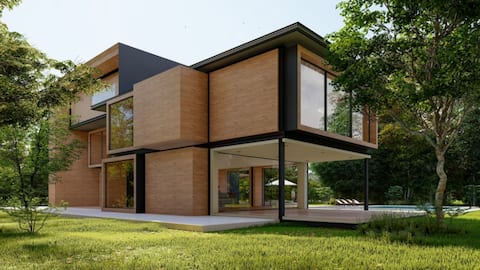Prefabricated homes: Expert shares why they are on the rise
What's the story
In recent years, the construction industry has undergone a significant transformation as it has witnessed the rise of prefabricated homes - an approach to sustainable development. For the uninitiated, a prefabricated home is a space that is manufactured in advance at a factory before it is shipped to the site. To understand this trend, NewsBytes touched base with Ms. Nidhi Aggarwal, founder of SpaceMantra.
Features
Process: Prefabrication of homes happens in the following stages
Aggarwal explains prefabricated homes by sharing the process involved in their construction. "The prefabrication process involves key stages: design and engineering, material procurement, component fabrication, quality control and testing, transportation to the building site, and final installation," she says. She adds that each of these stages contributes to the efficient and streamlined construction of prefabricated homes.
Benefits
Benefits: Aggarwal reveals the many benefits of prefab homes
According to the entrepreneur, there are many benefits of opting for a prefab home, which is why it is on the rise. She says that construction is efficient as "prefab homes embrace a streamlined manufacturing process in controlled factory environments" and sustainability is maintained "through standardized designs and precise measurements that reduce material wastage." It is also inexpensive and ensures quality checks.
Design
Design: There are so many designs one can go for
Aggarwal draws contradiction to popular misconceptions by saying that "prefab homes offer a diverse range of design options. From modern and minimalist to traditional and rustic, homeowners can choose any style." "Customization options allow individuals to personalize their homes according to specific needs and desires," she further reveals. Smart home integration, energy-efficient appliances, modularity, and increased durability are some salient features.
Trend
Trend: Why prefab homes are on the rise
Analyzing the upward graph of demand in prefab homes, Aggarwal says, "Several factors contribute to the growing popularity of prefab homes, including speedy construction, technological advancements, insurance benefits, urbanization, and appealing design." She cites that as per research, by 2024 it is expected that the prefabricated homes market will reach around Rs. 209 billion, reflecting a growing demand for affordable and environment-friendly alternatives.
Impact
Environmental impact: Are prefab homes the future of construction?
Prefab homes boast a significantly lower environmental impact compared to traditional construction methods, shares Aggarwal. "Their focus on energy efficiency, reduced waste, lower emissions, and the use of sustainable materials aligns with the urgent need for eco-friendly building practices," she states. According to her, incorporating prefab principles into traditional construction methods can pave the way for reduced waste, improved efficiency, and enhanced environmental protection.
